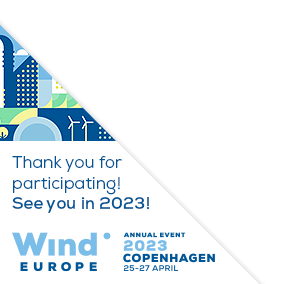Posters
Siblings:
ProceedingsProgrammeSpeakersPostersContent PartnersGlobal Markets TheatreWindTalks for InnovationProgramme Committee & Abstract ReviewersSpeaker's DashboardCome meet the poster presenters to ask them questions and discuss their work
Check the programme for our poster viewing moments. For more details on each poster, click on the poster titles to read the abstract. On Wednesday, 6 April at 15:30-16:15, join us on Level 3 of the Conference area for the Poster Awards!

PO132: Offshore wind turbine blade erosion: How to quantify the impacting weather conditions
Charlotte Hasager, Professor, DTU Wind Energy
Abstract
Some offshore wind turbines have suffered unexpected repair in recent years. The cost of unplanned repair due to blade erosion is 12 times higher than the cost of unplanned repair due to structural failure. The high repair cost for blade erosion is related to the logistics cost to make inspections, repair in rope access and downtime of turbines during repair. In addition, eroded blades produce less energy due to lower aerodynamic performance. The study focuses on a method to quantify the impacting weather conditions offshore that cause the blade damage. The erosion is caused by incremental damage during time when particles, such as hydrometeors, rain and hail, impact the leading edge of the blade and cause stresses in the protective coating and in the layers below (putty and glass-fiber substrate). More damage occurs for higher tip speed, for higher rain amount and for larger droplet sizes. Observations of rain intensity and wind speed at coastal meteorological stations recently have been used to predict the expected erosion and blade lifetime. Offshore data were not available. Offshore observations of precipitation and wind are sparse, so a novel method to quantify the impacting weather conditions offshore is based on remotely sensed observations from satellites orbiting Earth. The Global Precipitation Mission (GPM) and the level 3 product IMERG (Integrated Multi-satellitE Retrievals for GPM) from NASA are used in combination with measured and modelled winds. Our study area is offshore Portugal in the Atlantic Ocean. The work is part of ESA ARIA2.










Follow the event on: